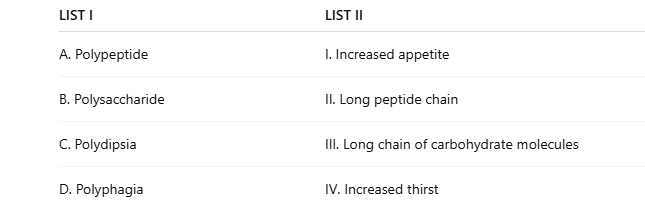Correct option is C
·
Polypeptide (A) is a chain of amino acids linked by peptide bonds. This matches with
II: Long peptide chain. Polypeptides are the building blocks of proteins and essential in biological functions.
·
Polysaccharide (B) is a complex carbohydrate made of many sugar units bonded together, matching with
III: Long chain of carbohydrate molecules. Examples include starch, glycogen, and cellulose.
·
Polydipsia (C) means excessive thirst, which is a medical symptom indicating abnormal fluid intake. Hence, it corresponds to
IV: Increased thirst.
·
Polyphagia (D) refers to excessive hunger or increased appetite, fitting with
I: Increased appetite.
Information Booster
Polypeptides are critical for life, forming enzymes, hormones, and structural proteins that regulate biological processes. The amino acids linked in long chains fold into specific shapes, determining protein function.
Polysaccharides serve as energy reserves (like glycogen in animals) or structural components (like cellulose in plants). Their long chains allow storage or support functions vital to living organisms.
Polydipsia and polyphagia are clinical symptoms often seen in diseases such as diabetes mellitus. Polydipsia results from the body’s need to replace lost fluids, while polyphagia reflects an abnormal increase in hunger signals due to metabolic imbalances.
Understanding these terms helps in biology, nutrition, and medical sciences by connecting molecular structure with physiological function and symptoms.






 English
English 50 Questions
50 Questions 60 Mins
60 Mins


